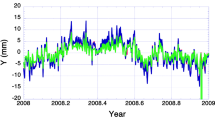Abstract
Doppler tracking of artificial satellites has been applied to determine the pole components through an experiment called MEDOC. In addition to developing scientific aspects dealing with polar motion, it is proposed to promote new observational techniques and to investigate the possibility of operating an international permanent service.
So far, nearly two years of bi-daily solutions have been derived. Each improvement of computational procedures, data processing and station component determination has contributed to better precision in the computed pole positions.
MEDOC pole coordinate solutions show good agreement with DMA and BIH global solutions corrected for annual terms. Differences of the smoothed values are less than one meter for both components.
The MEDOC experiment was initiated by the GRGS (Groupe de Recherches de Géodésie Spatiale) and took place in 1977 and 1978.
The experiment as presently organized will continue up to 1980. Future improvements are still foreseen by increasing the number of observing sites and refinement of the force models, but already international involvement is taking place in the MEDOC experiment.
Similar content being viewed by others
References
R.J. ANDERLE (1973): “Determination of Polar Motion from Satellite Observations”. Geophysical Surveys, 147–161.
BIH Annual Report 1977, 1978, 1979.
R.B. BLACKMAN and J.W. TUCKEY (1958): The Measurement of Power Spectra. Dover Publications, I, New York.
W.H. GUIER (1963): “Studies on Doppler Residuals, Dependence on satellite orbit error and station position error. APL. TG-503.
B. GUINOT (1978): “Irregularities of the polar motion”, Time and the Earth's rotation, IAU Symp. no 82, eds. D.D. Mc Carthy and John D.H. Pilkington, p. 279.
B. GUINOT and F. NOUËL (1976): “MEDOC Experiment”. Presented at the first Symposium of Satellite Doppler Positionning. Proc. Int. Geod. Symp. DMA and NOAA. Las Cruces, N.M.
H.S. HOPFIELD (1973): “Two Quartic Tropospheric Refractivity Profile for Correcting Satellite data” JGR 74 (18), 4487–4499.
L.C. JACCHIA (1965): “Static Diffusion Models of the Upper Atmosphere with Empirical Temperature Profiles” Astrophys. Spec. Rep. 170. Smithsonian Inst. Washington D.C.
F. NOUËL (1979): “MEDOC Experiment”. Presented at the Second Symposium of Satellite Doppler Positionning, Austin, Texas.
F. NOUËL, D. GAMBIS (1978): “Very first results of MEDOC Experiment”. Time and the Earth's rotation. IAU Symp. no 82, eds. D.D. Mc Carthy and John D.H. Pilkington, p. 295.
P. PAQUET and C. DEVIS (1978): “Reasons and Possibilities for an extended use of the Transit System”. IAU Symp. no 82, eds. D.D. Mc Carthy and John D.H. Pilkington, p. 287.
A. PIUZZI (1978): Private communication
Author information
Authors and Affiliations
Rights and permissions
About this article
Cite this article
Gambis, D., Nouël, F. Determination of polar motion by Doppler tracking of artificial satellite. Bull. Geodesique 54, 103–118 (1980). https://doi.org/10.1007/BF02521100
Received:
Accepted:
Published:
Issue Date:
DOI: https://doi.org/10.1007/BF02521100




